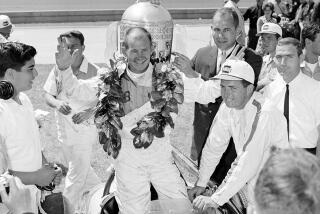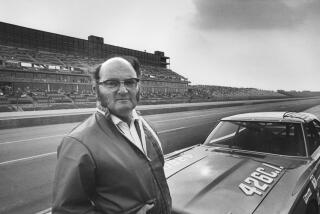Dan Wheldon was an engaging young champion
Based on nothing more than one lunch and 90 minutes of interviewing, it is clear that the world of IndyCar racing will be hurting for quite some time. It has lost a tremendous young talent, as well as a tremendous young person.
Yes, Dan Wheldon died doing what he loved to do. Yes, racing cars at speeds in excess of 200 mph is dangerous, and those who do it know it.
And yes, his death in a fiery 15-car crash Sunday at Las Vegas Motor Speedway was so horrific that the word âcarnageâ kept coming up in news reports.
Those are the boilerplate observations. More appropriate at the moment is a discussion of the person he was.
Wheldon was 33 years old, and a two-time Indianapolis 500 winner, including this year. He flaunted none of that. He looked you in the eye when he shook your hand, he asked questions as well as answered them, and he had a sense of humor that included a taste for others who also had one.
Last Tuesday, Wheldon was on a promotional swing, creating media attention for the unique challenge he was attempting at the Las Vegas race. He would start last in a field of 34 and try to make his way all the way to the front at the end. If he did so, he would share $5 million with a randomly selected fan.
He was quick to put the promotion, and its gimmick aspects, into context.
âI donât need money to be the incentive,â he said.
Others in sportsâ saying that would prompt an eye roll. Wheldon, young, movie-star handsome, and ideally positioned to say something like that and not mean it, really did. After youâve done several hundred interviews, it becomes easier to separate the hot dog from the bun.
The interview took place at a Los Angeles restaurant. Wheldon was double-teamed by two sportswriters, both veterans of this and both longtime friends inclined to needle each other between questions. Wheldon seemed to enjoy the shots taken and given by Doug Krikorian, longtime Long Beach Press-Telegram columnist. He kept score and announced it at the end.
He was remarkably less full of himself than most athletes who had accomplished things on his level. Two Indy 500s can turn a walk into a swagger quickly. Wheldon just walked.
With little prompting, he talked much more about others than himself. A situation came up where he had taken over a car from driver Alex Tagliani for a recent race in Kentucky. He was asked why Tagliani would give up that ride.
âAlex is just a nice guy,â Wheldon said.
He was asked about the presence of Danica Patrick on the Indy circuit. It was a perfect opportunity to do the macho thing, to openly or subtly put her down or question her ability or place in a testosterone-dominated sport. Instead, he replied with a story.
âShe did wonders for all us guys, for getting us in shape,â he said. âWhen she first came on the circuit, weâd wonder why she was so much quicker than we were. Then our teams started leveling with us, explaining that her car was 50 pounds lighter every time she got into it, because she was 50 pounds lighter.
âPretty soon, we were all in the gym.â
He lighted up when he talked about family. He told of his motherâs recent diagnosis of Alzheimerâs, about how his three brothers and sister wanted nothing to do with racing. He described his fatherâs plumbing and heating business in England, based in the area 40 miles north of London where he came from.
âItâs England, after all,â Wheldon said, âso he certainly does more work in heating than air conditioning.â
And he talked about the blessing for him and his wife, Susie, that he didnât have a regular ride this season on the Indy circuit, despite being the Indy 500 winner.
âWe had our second son [Oliver],â Wheldon said, âand I got to be with the family a lot.â
A reporter showed him a picture taken the day after this yearâs Indy victory. In it is Wheldon, his orange-and-white No. 98 car that won the race, and his incredibly cute, towheaded oldest son, Sebastian, 2, sitting on the fabled Indy bricks. Wheldon glowed when he related how he had bent over to kiss the bricks for photographers, and how Sebastian, unprompted, had done the same.
As well as the story of his attempted dash from last to first came through, so did the personality of the person telling the story. Wheldon was driven to win, proud of his accomplishments, but not the least bit inclined to shove them down your throat.
In the days and months ahead, the blame game will begin. As a society, we seem to have to do this.
Randy Bernard, IndyCar chief executive, whose idea it was for a $5 million-motivated dash from the back, will take some hits. Did this gimmick compromise race safety?
There will be discussion about how the accident started.
Early reports pointed to a bump between Wade Cunningham and JR Hildebrand. The coincidence of that is clear. Hildebrand was the driver who crashed on the last lap of this yearâs Indy 500, allowing Wheldon to flash past and lead the race for the last 912 feet. Cunningham was the driver who, contractually locked in to race the car in which Wheldon won the 500 the next week in Texas, crashed it.
Right now, none of that matters, What does is the proper memory of a talented and personable driver for whom they paraded in sorrow Sunday at Las Vegas and played âAmazing Graceâ and âDanny Boyâ over the loudspeaker.
The âDanny Boyâ works on at least two levels. Dan Wheldon was born in England but was proud that he was of Irish descent.
The âAmazing Graceâ speaks for itself. There are family, friends and fans who can attest to that.
Also, a couple of old sportswriters.
More to Read
Go beyond the scoreboard
Get the latest on L.A.'s teams in the daily Sports Report newsletter.
You may occasionally receive promotional content from the Los Angeles Times.











